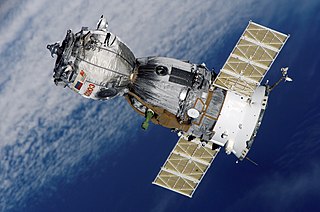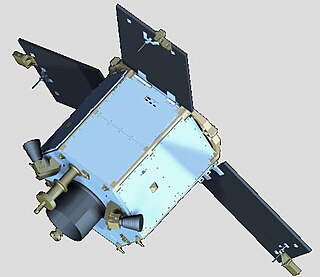
A spacecraft is a vehicle that is designed to fly and operate in outer space. Spacecraft are used for a variety of purposes, including communications, Earth observation, meteorology, navigation, space colonization, planetary exploration, and transportation of humans and cargo. All spacecraft except single-stage-to-orbit vehicles cannot get into space on their own, and require a launch vehicle.
The Space Test Program (STP) is the primary provider of spaceflight for the United States Department of Defense (DoD) space science and technology community. STP is managed by a group within the Advanced Systems and Development Directorate, a directorate of the Space and Missile Systems Center of the United States Space Force. STP provides spaceflight via the International Space Station (ISS), piggybacks, secondary payloads and dedicated launch services.

DubaiSat-1 is a remote sensing Earth observation satellite built by the Mohammed bin Rashid Space Centre (MBRSC) under an agreement with Satrec Initiative, a satellite manufacturing company in South Korea.
ITUpSAT1, short for Istanbul Technical University picoSatellite-1, is a single CubeSat built by the Faculty of Aeronautics and Astronautics at the Istanbul Technical University. It was launched on 23 September 2009 atop a PSLV-C14 satellite launch vehicle from Satish Dhawan Space Centre, Sriharikota, Andhra Pradesh in India, and became the first Turkish university satellite to orbit the Earth. It was expected to have a minimum of six-month life term, but it is still functioning for over two years. It is a picosatellite with side lengths of 10 centimetres (3.9 in) and a mass of 0.990 kilograms (2.18 lb).

TÜBİTAK Space Technologies Research Institute or TÜBİTAK UZAY for short, is a Turkish institution carrying out research and development projects on space technology, electronics, information technology, and related fields. It was established in 1985, under the name "Ankara Electronics Research and Development Institute" within the campus of Middle East Technical University (ODTÜ) in cooperation with the Scientific and Technological Research Council of Turkey and the university in Ankara. In 1995, the organization was renamed. Since 1998, the institute has been a new building on the campus.

A space tug is a type of spacecraft used to transfer spaceborne cargo from one orbit to another orbit with different energy characteristics. The term can include expendable upper stages or spacecraft that are not necessarily a part of their launch vehicle. However, it can also refer to a spacecraft that transports payload already in space to another location in outer space, such as in the Space Transportation System concept. An example would be moving a spacecraft from a low Earth orbit (LEO) to a higher-energy orbit like a geostationary transfer orbit, a lunar transfer, or an escape trajectory.

DubaiSat-2 is an electro-optical Earth observation satellite built by the Mohammed bin Rashid Space Centre (MBRSC) under an agreement with Satrec Initiative, a satellite manufacturing company in South Korea. MBRSC's objective with DubaiSat-2 is to provide electro-optical images, that can be commercialized, for users within the United Arab Emirates and beyond and to develop and implement new technologies not used in DubaiSat-1. MBRSC also intends to continue manpower training for the UAE's space program. 16 UAE engineers have been working on the design, development, testing and manufacturing of the satellite. The participation of the UAE engineers, who are currently working in South Korea, has increased by 100 percent from the DubaiSat-1 project.

Göktürk-2 is an Earth observation satellite designed and developed by the Scientific and Technological Research Council of Turkey (TÜBİTAK) and built by TÜBİTAK Space Technologies Research Institute and Turkish Aerospace Industries (TUSAŞ) for the Turkish Ministry of National Defence.
RASAT was an Earth observation satellite designed and developed by TÜBİTAK Space Technologies Research Institute and produced in Turkey to provide high resolution imagery. It was the first remote sensing satellite fully realized in Turkey, and the second indigenously developed remote sensing satellite after BILSAT-1.
BILSAT-1 was an Earth observation satellite designed and developed by TÜBİTAK Space Technologies Research Institute and produced in Turkey as part of the Disaster Monitoring Constellation (DMC) project in the context of a show-how program led by DMC International Imaging of Surrey Satellite Technology (SSTL).

Planet Labs PBC is a publicly trading American Earth imaging company based in San Francisco, California. Their goal is to image the entirety of the Earth daily to monitor changes and pinpoint trends.
Türksat 6A is Turkey's first fully domestically produced communications satellite, successfully launched on July 8, 2024
Satellogic Inc. is a company specializing in Earth-observation satellites, founded in 2010 by Emiliano Kargieman and Gerardo Richarte.
NanoAvionics Corp is a small satellite bus manufacturer and mission integrator founded as a spin-off from Vilnius University, Lithuania in 2014.
SHERPA is a commercial satellite dispenser developed by Andrews Space, a subsidiary of Spaceflight Industries, and was unveiled in 2012. The maiden flight was on 3 December 2018 on a Falcon 9 Block 5 rocket, and it consisted of two separate unpropelled variants of the dispenser.

ÑuSat satellite series, is a series of Argentinean commercial Earth observation satellites. They form the Aleph-1 constellation, which is designed, built and operated by Satellogic.

The Space Rider is a planned uncrewed orbital lifting body spaceplane aiming to provide the European Space Agency (ESA) with affordable and routine access to space. Contracts for construction of the vehicle and ground infrastructure were signed in December 2020. Its maiden flight is currently scheduled for the third quarter of 2025.

Satrec Initiative Co., Ltd. or SI is a South Korean satellite manufacturing company headquartered in Daejeon, South Korea The company was founded in 1999 by the engineers who developed the first Korean satellite (KITSAT-1) at KAIST SaTRec. The company designs and builds Earth observation satellites called SpaceEye-series, and it provides various space components, including high resolution electro-optical payloads and star-trackers. SI's first satellite was a Malaysian Earth observation satellite, RazakSAT launched in 2009. SI has two subsidiaries: SI Imaging Services (SIIS) is the exclusive image data provider of KOMPSAT-series, and SI Analytics (SIA) provides AI-native GEOINT solutions for satellite imagery. SI also spun-off SI Detection (SID), which provides radiation monitoring solutions.

The Bayraktar Kızılelma is a single-engine, low-observable, carrier-capable, jet-powered unmanned combat aerial vehicle (UCAV), currently in development by Turkish defense company Baykar. The aircraft is being developed as part of Project MIUS. The initial Bayraktar Kızılelma (Kızılelma-A) is subsonic. Planned variants are intended to be supersonic, the latter having a twin-engined configuration. It is one of the two Turkish jet-powered stealth UCAV along with TAI Anka-3.
This is a list of satellites of Turkey.










